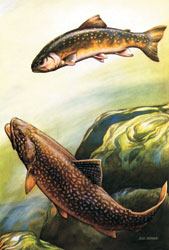Feasting on fresh fish
by chef Ann Oliver
Australian Shooter November 2004
I recently watched a documentary on the amazing journey of the wild salmon. The salmon throw themselves upstream in their instinctive urge to mate. Exhausted and dying, their rotting bodies provide nutrient-rich water for their young. Many apparently die on the journey, yet it is this bizarre cycle of life and death that controls their complete existence.
 When farmed salmon first became available in Australia, we chefs used to dread the spawning season. We watched the normally pink flesh go grey and the luscious fatty flesh become tight and dry. Even removing the bones became more difficult; the flesh seem welded to them.
When farmed salmon first became available in Australia, we chefs used to dread the spawning season. We watched the normally pink flesh go grey and the luscious fatty flesh become tight and dry. Even removing the bones became more difficult; the flesh seem welded to them.
I have never caught salmon or trout in the wild. It is one of those dreams I still long to fulfil. Many of my winemaker friends have long associations with the snow regions of Australia, in particular, Thredbo, and all have stories of trout fishing. My friends embellish the truth - the fish is always huge, always difficult to catch...
These friends have eaten in some of the world’s best restaurants, yet it is never the grand restaurant meal that is favoured. A good friend of mine, Len Evan, can certainly claim to have eaten at the world’s best tables, yet it is his description of a camp-cooked trout that leaves me salivating.
“Probably the most memorable meal I ever had was when I was cold, wet and hungry. Four of us were lake-fishing for trout in the Australian Alps and the weather had turned nasty. The fish were down and nothing enticed them. Someone put a horrible green-red thing on his leader, a cross between a fly, a nymph and a small frog. Still fishing with a floating line, he dispiritedly cast onto the lake. This awful fly had only just dipped under the surface of the water when it was off like an express train. Fifteen minutes later, a magnificent four-pounder was ours - a rainbow trout.
“Quickly we gutted and cleaned the fish and rolled it in wet newspaper - four sheets of it. Each piece was individually wetted and wrapped around the fish. While the fish was being wrapped, a small brush fire was lit. The fish went straight into it. No coals were necessary because the newspaper acted as a steaming jacket and, though the outside layers eventually burned, the inside ones stayed moist.
“Twenty minutes later and the papers were peeled off. It took the skin with it, to reveal the moist, succulent, steaming flesh. This was taken from the bone and placed on slices of Dr Vogel’s bread, the nutty wholegrain kind, spread with butter. Fresh-ground black pepper on top and the fish was eaten straight away. The wine was an old Hunter semillon from 1960. They age magnificently, acquiring a deep green-gold color, a fragrant nose and a huge depth of flavour.
This wine and fresh bread and trout, eaten within 40 minutes of landing, on a bitterly cold day, remains one of the most memorable meals of my life.”
When I was involved with the opening the Radisson Hotel in Adelaide, hotel guests would frequently return from Kangaroo Island with fresh fish. They would beg for me to cook it. I always did it the same - butter, olive oil, salt, pepper and lemon. Often, my guests were dismayed by how ‘basic’ my fish-cooking was. Until they tasted it. Fresh fish is so difficult to buy these days. Farmed fish can still deliver the preferred 24 hours from farm to plate, but fish caught in the deep sea can often spend days in the bloody ice slurry before it gets to the restaurant. It is not ideal and the reason why most restaurants opt for farmed fish. Freshly caught fish needs no embellishment, however, salt and pepper always enhances the flavour. Fresh water fish requires good seasoning; not adding it before cooking will leave the fish tasting slightly bland.
Wrapping fish in river clay is one of the easiest ways of cooking it, but it does require good coals - to get enough heat into the fish to cook it through. Seasoning the fish liberally inside the cavity and on the skin is essential. Wrap the fish evenly in two-centimetre-thick clay, place in a bed of coals and cover with coals. Of course, size is a factor in the cooking time, but a 1.5kg-2kg fish should take about 45 minutes. If you want to make absolutely certain the fish is cooked, make a small hole in the clay at the middle where the fish is thickest. Before removing the fish from the fire, stick a skewer into the centre of the fish, rest it for a couple of minutes and remove it; it should be hot. Your fish is cooked!
Small fish go straight into the pan with nothing more than butter, extra-virgin olive oil, salt and pepper.
